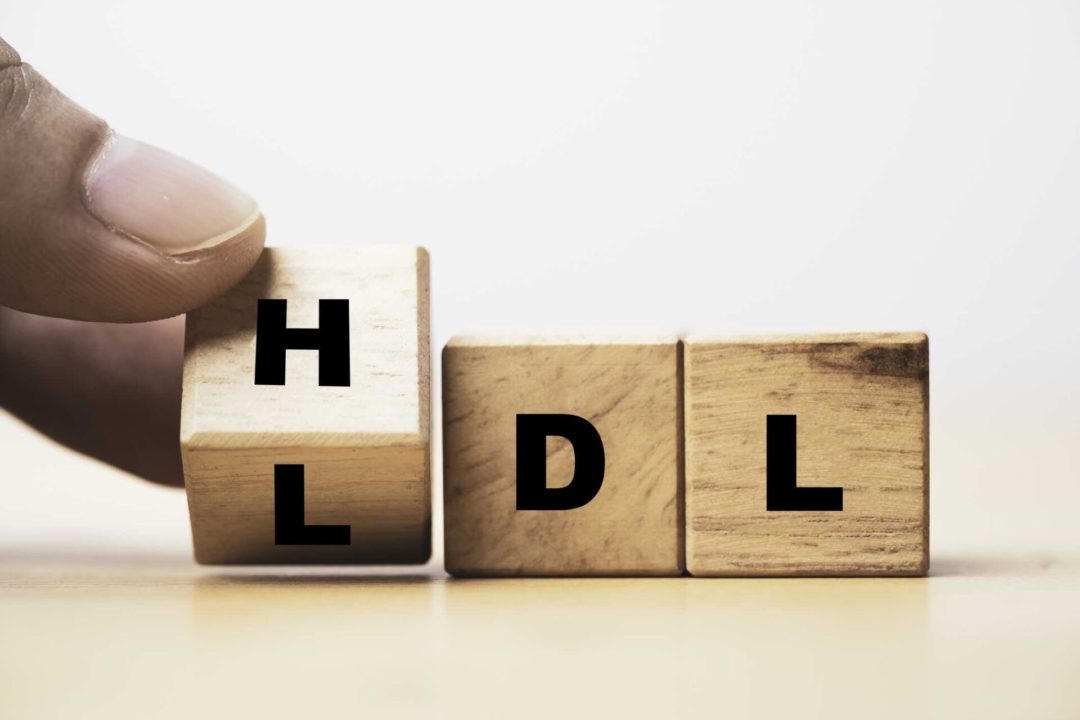Here are the three assumptions. See how many you agree with.
- There are two kinds of cholesterol, one “good” (HDL) and one “bad” (LDL).
- Saturated fat raises LDL and therefore saturated fat raises the risk for heart disease.
- Lowering LDL (and/or raising HDL) saves lives.
There aren’t.
Cholesterol doesn’t come in two flavors
Thereis no such thing as “good” and “bad” cholesterol. “Good” and “bad” cholesterol are names we made up decades ago to describe two different types oflipoproteins. Spoiler alert: Lipoproteins are where the action is. More on that later.The cholesterol in HDL and the cholesterol in LDL is the exact same molecule—and, incidentally, it’s one of the most important (and misunderstood) molecules in your body, very different from the Public Enemy Number One it’s been declared to be. And cholesterol doesn’t change character depending on what train it’s hitching a ride on. It does not come in two flavors (“good” and “bad”).
So how did this notion of “good” and “bad” cholesterol come about?
Let’s start with some basics. Cholesterol can’t travel in the blood—it’s hydrophobic, meaning it doesn’t mix with water—so it needs to be carried around the bloodstream in some kind of container. The containers—calledlipoproteins—are theboats; cholesterol is thecargo.Cholesterol’s not the only cargo carried by a lipoprotein, mind you. It shares the cargo area with triglycerides, protein, and phospholipids. Depending on the weight of the collective amount of cargo, some of the lipoproteins arehigherdensity (heavier), while others are lower density (lighter) (7). To extend the boat analogy, boats carrying feathers will float, boats carrying bricks will sink.
When a boat crashes, its cargo usually spills out into the water, and that’s exactly what happens with lipoproteins when they crash into the artery wall. When an oxidized or inflamed LDL particle takes up residence in the endothelial lining where it doesn’t belong, it initiates a long sequence of events that eventually leads to plaque.
Blaming the firefighters for the fire
Let’s remember how plaque starts in the first place. First, a rogue molecule—most often an LDL—breaks through a dysfunctional or damaged section of the endothelial wall and parks where it doesn’t belong. Once that LDL particle gets into that sub-endothelial space, others follow, like cockroaches in a New York apartment. They become like “squatters,” taking up “illegal residence” in the artery wall. They bind to substances called proteoglycans in the arterial wall and become a magnet for oxidative forces. This institutes a full-on inflammatory response. Mayhem ensues.Cholesterol, the cargo of the damaged lipoproteins, spills out into the blood just like the contents of a picnic basket in an overturned rowboat spills into the lake. Cholesterol is always present at these accident sites, which lead to the understandable assumption that cholesterolitselfis the problem.
But it was theboat—the lipoprotein—that was the initiating problem, not thecargo(cholesterol). As I said long ago on The Dr. Oz Show, blaming cholesterol for heart disease is like blaming the firemen for the fire. Firemen are found at the scene of the fire, but they didn’t light the match.
Is it the boat? Or is it the cargo?
The next thing to understand is how important the lipoproteins themselves are, far more important than the cargo they’re carrying. I mean, if you’re in charge of a marina, and you want to prevent boating accidents, what’s the most important thing you probably want to know?It’s probablynot“How many sodas in the boat’s beverage cooler?” It’s “How manyboatsare there in thewater?”
Which brings me to the case for retiring the “good” and ”bad” cholesterol test.
The ability to really look under the lipoprotein hood has grown exponentially in the last decades. We now have tests—generically called "particle tests" or "advanced lipid profiles"—that have identified at least a dozen different kinds of lipoproteins including oxLDL, Lp(a), LDLa, LDLb, HDLlla, HDLllb, etc. (8). The number and size of these lipoproteins produces diagnostic information that is much better than the old-fashioned “good” and “bad” cholesterol test, which is, as we’ll see, prone to an enormous amount of false positives and false negatives.Here’s an example of someone whose risk wentundetected because of a “false negative” using the conventional test: Me.
My total cholesterol was 164 and my LDL was 100. Negative for risk by any conventional standards. These were numbers any traditionally trained doctor would be delighted to see.
But it was a false negative.
It told me I was fine when I really wasn’t. (A falsepositivewould tell you you’re at risk when you really aren’t.)When I finally took the much more comprehensive particle test, it revealed a very different story about myreallevel of risk.
My particlenumber(2300) was in “high-risk” territory. There were just too many LDL particles floating around my bloodstream (even though they didn’t carry a lot of cholesterol). What’s more, they were the worsttypeof particles—the small, dense atherogenic particles most likely to cause damage as opposed to the big fluffy (and relatively harmless) ones. When you have mostly “good” LDL (the big fluffy particles) you’re said to have Pattern A. When you have mostly nasty ones, as I did, you’re said to have Pattern B. All of this information is visible on the modern lipid tests, but is hidden from sight if you depend, as I had done, on the old-fashioned test.
Who benefits from advanced lipid testing? Maybe everybody.
When one test calls you low-risk and another calls you high-risk, the tests are said to bediscordant. (If the tests agree, they areconcordant.)When given both tests, diabetics and pre-diabetics are the ones most likely to have discordant results when given both tests (9,10). So they’re the ones most likely to benefit from advanced testing. Problem is, the majority of Americansarepre-diabetic (I’ll explain that shocking statement in a minute).
The more insulin resistant you are, the more you’re likely to be in the “higher risk” category when lipids are measured in the proper way. If someone with pre-diabetes or diabetes gets a green light on the HDL-LDL test but a red light on the particle test, pay attention to the later not the former.
And here’s the kicker: According to the most recent NHANES study, 88% of Americans havesome degree of pre-diabetes(insulin resistance) (11,12). That means the particle tests are far more likely to give accurate information aboutrisk for the vast majority of Americans.
Andthat’s the best argument for shifting over to the modern lipoprotein fractionization tests. They’re offered by every major lab, including Quest Diagnostics and LabCorp (13,14). My favorite test is the LabCorp LP-IR, which also measures insulin resistance (15).
For 88% of us—and our patients—the particle test is the way to go. Continuing to measure risk using “good” and “bad” cholesterol metrics is like using a flip phone in the age of the iPhone 13 Pro.
REFERENCES
- https://pubmed.ncbi.nlm.nih.gov/20071648/
- https://www.acpjournals.org/doi/10.7326/m13-1788
- https://www.healthline.com/nutrition/5-studies-on-saturated-fat
- https://www.ahajournals.org/doi/10.1161/01.cir.103.13.1823
- https://www.ncbi.nlm.nih.gov/pmc/articles/PMC4917787/
- https://www.aafp.org/afp/2015/0115/p133.html
- https://www.britannica.com/science/lipid/Classification-and-formation
- https://www.ncbi.nlm.nih.gov/pmc/articles/PMC4060612/
- https://lipidworld.biomedcentral.com/articles/10.1186/s12944-021-01445-5
- https://www.ncbi.nlm.nih.gov/pmc/articles/PMC4625988/
- https://www.liebertpub.com/doi/10.1089/met.2018.0105
- https://www.unc.edu/posts/2018/11/28/only-12-percent-of-american-adults-are-metabolically-healthy-carolina-study-finds/
- https://testdirectory.questdiagnostics.com/test/test-detail/92145/advanced-lipid-panel-cardio-iq?cc=MASTER
- https://www.labcorp.com/tests/123810/nmr-lipoprofile-with-lipids-with-graph
- https://www.labcorp.com/assets-media/2307










